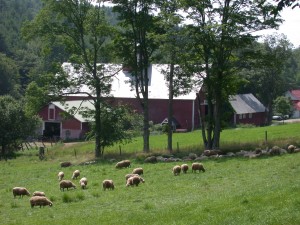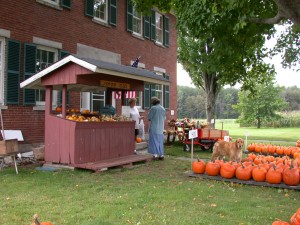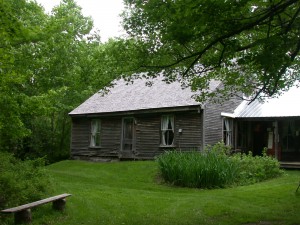Rooted in the Soil
 Farming’s handprints are all over our working landscape, from loamy flood plains to rocky hill farms. For two-and-a-half centuries, farmhouses, barns, pastures, and cultivated fields have marked determined efforts to build a life upon the soils of the Northern Valley.
Farming’s handprints are all over our working landscape, from loamy flood plains to rocky hill farms. For two-and-a-half centuries, farmhouses, barns, pastures, and cultivated fields have marked determined efforts to build a life upon the soils of the Northern Valley.
Those efforts were first devoted to subsistence farming by settlers in the late 1700s. Nearly everyone farmed, and ate food grown close to home. People flocked to farmers’ markets in the larger towns. The introduction of Spanish Merino sheep in the early 1800s transformed the landscape. Forests were cleared to create pastures, and sheep outnumbered people. Local industries sprang up to process wool and several communities took shape around textile mills. Other towns grew up near factories that made farm equipment, tools, and wood products. Railroads enabled farmers to find markets in Boston and New York for commercial crops of butter, cheese, wool, and milk.
Agriculture is still an important part of our regional economy. It shapes the look and feel of our communities, and flavors everyday life. Our regional culture grew from the roots settlers put down in the soil. Shorten your personal food chain and pick up your produce directly from the producers – of sharp cheeses, tangy apples, sweet maple syrup, and much more.
communities, and flavors everyday life. Our regional culture grew from the roots settlers put down in the soil. Shorten your personal food chain and pick up your produce directly from the producers – of sharp cheeses, tangy apples, sweet maple syrup, and much more.
Each summer, agricultural fairs along the Byway draw spectators and participants to competition for the best matched and strongest teams of oxen to the most delicate quilt stitchery. Here’s a chance to enjoy the sounds and sights of farm days past – and present.
 The Poore Family Homestead in Stewartstown, NH displays the 1826 homestead, barns, furnishings, and tools of this early hill farm, reflecting the traditional spirit, values, and way of life of settlers of the Connecticut River Valley headwaters. The large barn, with its impressive high drive, shelters displays of original farm machinery and household necessaries used by generations of the Poore family: a full loom, spinning wheels, the original hay wagon carriages, and sleighs, farm tools, games, clothing, medicines, journals, and Civil War-era letters.
The Poore Family Homestead in Stewartstown, NH displays the 1826 homestead, barns, furnishings, and tools of this early hill farm, reflecting the traditional spirit, values, and way of life of settlers of the Connecticut River Valley headwaters. The large barn, with its impressive high drive, shelters displays of original farm machinery and household necessaries used by generations of the Poore family: a full loom, spinning wheels, the original hay wagon carriages, and sleighs, farm tools, games, clothing, medicines, journals, and Civil War-era letters.
From Farm to Table